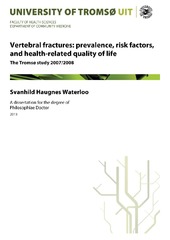Vertebral fractures: Prevalence, risk factors, and health-related quality of life. A cross-sectional study The Tromsø study 2007/2008
Permanent link
https://hdl.handle.net/10037/5557View/
Thesis introduction (PDF)
Waterloo S, Ahmed LA, Center JR, Eisman JA, Morseth B, Nguyen ND, Nguyen T, Sogaard AJ, Emaus N.: 'Prevalence of vertebral fractures in women and men in the populationbased Tromsø Study', BMC Musculoskeletal Disorders (2012), vol. 13:3. (PDF)
Waterloo S, Nguyen T, Ahmed LA, Center JR, Morseth B, Nguyen ND, Eisman JA, Sogaard AJ, Emaus N.: 'Important risk factors and attributable risk of vertebral fractures in the population-based Tromsø Study', BMC Musculoskeletal Disorders (2012), vol. 13:163. (PDF)
Waterloo S, Sogaard AJ, Damsgard E, Ahmed LA, Morseth B, Emaus N.: 'Vertebral fracture and self-perceived health in elderly women and men: The Tromsø Study, a population-based cross-sectional study', BMC Geriatrics (2013), vol.13:102 (PDF)
Date
2013-11-08Type
Doctoral thesisDoktorgradsavhandling
Author
Waterloo, Svanhild HaugnesAbstract
Summary
Background: Osteoporotic fractures constitute a major health burden in western societies. Forearm, vertebral-, and hip fractures are the most common types. Norway has the highest reported prevalence of forearm- and hip fractures. Little data has been available concerning vertebral fractures, although these, together with the hip fractures, are associated with increased morbidity and mortality.
The aim of this thesis was to describe the prevalence of vertebral fractures in a general population, and to study important, associated risk factors and health-related quality of life.
Material and method: Information on prevalent vertebral fractures was ascertained by a vertebral fracture assessment (VFA) method (dual-energy X-ray absorptiometry (DXA), GE Lunar Prodigy) in 2887 women and men, mean age 65.4, in the population-based Tromsø Study 2007-08. Bone mineral density (BMD; g/cm²) was measured at the hip by DXA. Demographic factors, lifestyle, and health-related quality of life information was collected by questionnaires. To explore associations, we used logistic and multiple regression analyses.
Results: Vertebral fractures were found with an equal distribution of 12 % in women and 14 % in men, most common between 1st lumbar and 6th thoracic vertebra. In both sexes, the number of vertebral fractures increased with increasing age and declining BMD. Population attributable risk fraction for these two factors was 46% in women and 33% in men. Self-reported health-related quality of life was reduced in women with vertebral fractures compared to those without. In men there was no difference, indicating that prevalent vertebral fractures does not necessarily have an impact on men’s self-perceived health.
Conclusions: The prevalence of vertebral fractures in this population was lower than expected. Men had similar fracture rates as women, but less bothered. These findings deserve a longitudinal follow-up.
Description
Publisher
UiT-Norges arktiske universitetUiT-The Arctic University of Norway
Series
ISM skriftserie, nr 143Metadata
Show full item recordCollections
Copyright 2013 The Author(s)
The following license file are associated with this item:


 English
English norsk
norsk
